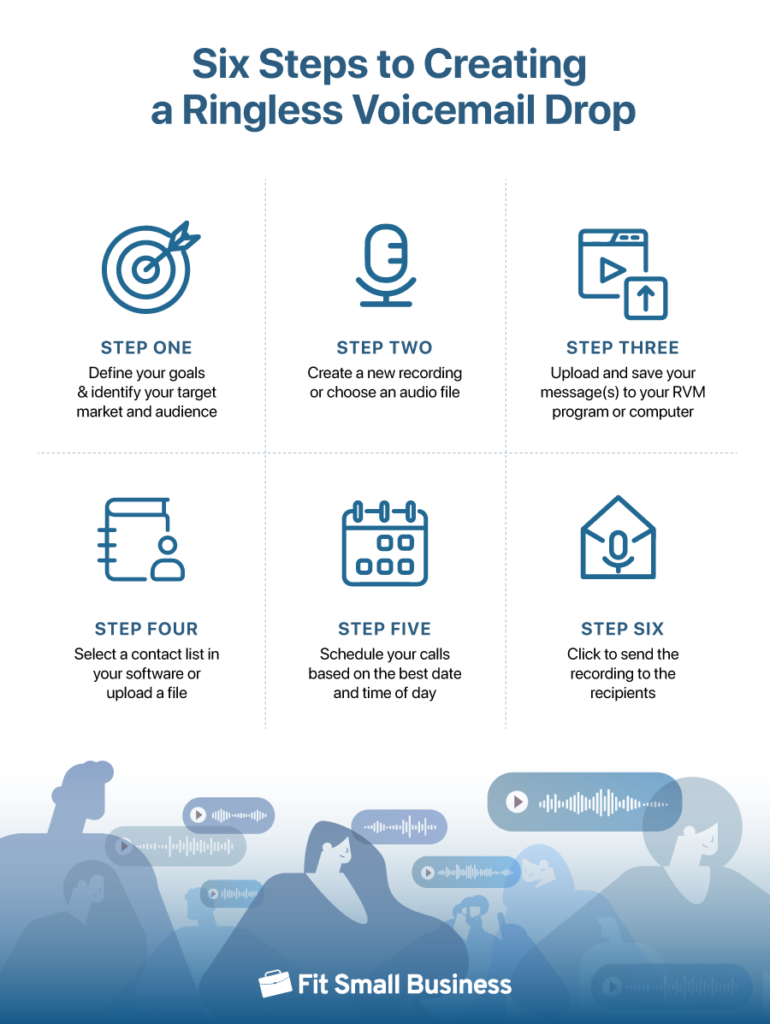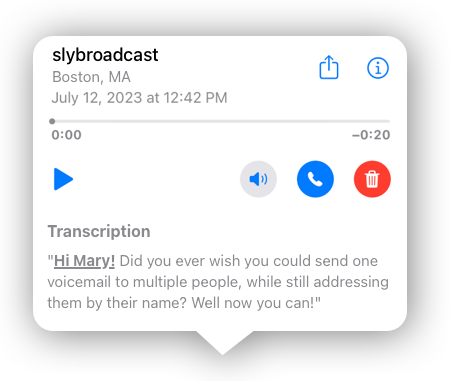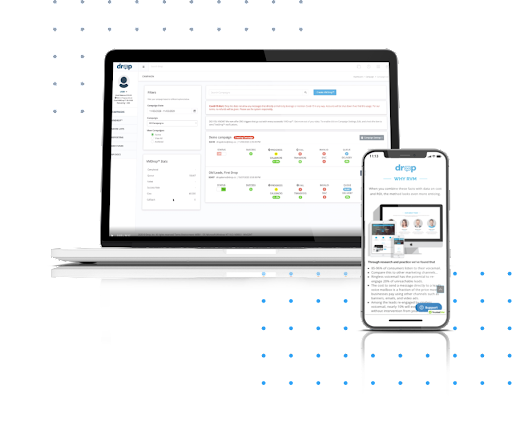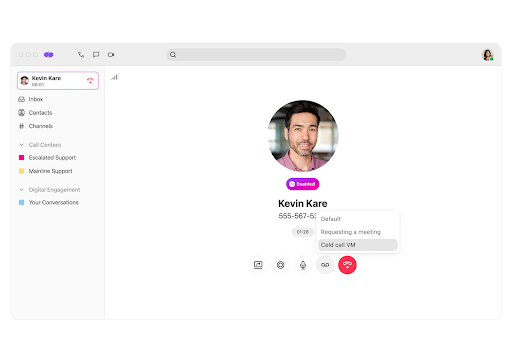Ringless voicemail drop (RVM) allows users to leave prerecorded messages without ringing a recipient’s line. This technology enables businesses to send reminders, share information and updates, and collect billables without interrupting their customers’ day. RVM streamlines the process of reaching out to prospects and colleagues while ensuring personalization. In this article, we’ll explore voicemail drop, how it works, its benefits, and the top service providers for small businesses.
How Voicemail Drop Works
RVMs work by sending prerecorded audio messages directly to a recipient’s voicemail inbox without ringing their cell phone. During an outbound call, agents dial a number and are automatically connected to voicemail, where they “drop” a prerecorded message. Agents can hang up and move to the next call, while the previous call continues until the message has finished playing.

RVM, or direct-to-voicemail software, uses a server-to-server method that facilitates direct voicemail placement into recipients’ mailboxes without ringing. Using adaptive signaling technology, it connects to the voicemail servers of the recipient’s provider and sends audio messages to the phone system’s back-end, directly into the recipient’s voicemail inbox. RVM bypasses the phone call function, leaving a voicemail alert and a missed call notification.
Setting Up Ringless Voicemail Drop
Using automated voice messaging saves time and increases agent productivity because team members don’t need to dial phone numbers or listen to voicemails. RVM pulls numbers from your contact list, dials the numbers, and places a recorded message into a receiver’s voicemail without making the phone ring. Whether you’re using RVM to boost sales, reach out to leads, or share information with target audiences, voicemail drop setup generally only takes a few steps:
- Define your goals and identify your target market and audience
- Create a new recording or choose an audio file
- Upload and save your message(s) to your RVM program or computer
- Select a contact list in your software or upload a file
- Schedule your calls based on the best date and time of day
- Click to send the recording to the recipients
Ringless voicemail delivers personalized messages while streamlining the calling process, giving agents more time to focus on other tasks and responsibilities. It’s important to note that not all dialers and voice-over-internet-protocol (VoIP) phone systems have fully automated voicemail drops. Depending on your provider, once the call goes to voicemail, you may need to tap a button to drop the message. Check each service provider’s list of VoIP phone features to see if voicemail drops are available and how it works.
It’s important to note that the Federal Communication Commission (FCC) considers RVMs as calls similar to text, SMS, and internet-to-phone messages, and are therefore subject to the Telephone Consumer Protection Act (TCPA). Before using ringless voicemail products, businesses must obtain consent before dropping voicemails into consumers’ voicemail boxes.
Did you know that ringless voicemail works on business landlines as well? Callers can deliver voicemail messages to both landlines and mobile phones as long as the carrier or phone service provides the receiver’s number with voicemail functionality.
Benefits of Using Ringless Voicemail Drop Service
RVM has recently gained popularity because it offers several benefits, from increasing time savings to quality customer conversations and sales. Here are some of the main advantages of using this technology:
Live Agent reports that, on average, call center agents spend 31.8 minutes talking to customers out of every activity hour. Of that one hour, another 5.22 minutes are spent being idle. RVM systems save customers and sales representatives a lot of time by speeding up dialing, listening to the phone ring, and leaving a message. RVM lets small businesses with lean teams regain time by cutting out wasted, idle time.
Using prerecorded messages ensures your brand tone and messaging is consistent. Regardless of who makes the call and when, each voicemail message is uniform, personalized to the caller or target audience, and sounds lively and polished every time. Use templates to create several voicemail drop recordings to prepare a message for every type of lead or situation.
Our advice is to focus on two things: personalization and relevance. Here’s a basic structure for prerecorded messages:
- Your name or company
- Purpose for calling
- Key message and benefits they stand to gain
- Your contact information
- Call to action or promise to follow up
Tip: While the length of voicemails depends on the carrier and provider, it’s best to leave messages that are 30 seconds or less. Respect your client’s time and keep your messages short and intriguing. Ensure to include information on contacting you and take the time to follow up with prospects promptly.
Optimize sales outreach and boost marketing efforts by delivering well-constructed messages and leaving a great first impression. RVM helps speed up the sales process by scaling your reach at a fraction of the time and cost. The more messages you send and prospects you engage, the higher your sales turnover.
One of the critical advantages of using RVM lies in its non-intrusive nature. Because your messages go straight to their mailbox, you don’t interrupt your prospect or customer and allow them to listen to your message at their convenience. This voicemail marketing approach leaves a voicemail notification, and some providers let you customize your caller ID on mobile phones so prospects and customers can return your call quickly.
Disadvantages of Using Ringless Voicemail Drop Service
RVMs are employed in different ways, including marketing, sales, and customer service. While it has revolutionized customer interaction and time management for customer service representatives, potential concerns regarding using voicemail drop systems include limited human interaction and missed messages.
Even with alerts and notifications, some voicemail recipients opt to check their voicemail messages during their free time. This means there could be delays in people hearing your messages, or recipients may think voicemails are mostly spam.
Consider a mix of communication channels, such as text messaging and RVMs, to ensure your customers or target audiences receive your messages through their preferred channels.
Voicemail drops don’t allow two-way interactions with recipients, which may be a drawback for businesses that want to engage their customers in a conversation. While audio recordings may be well scripted and designed, it does not replace personal conversations. To address this concern, check out our professional voicemail greetings and tips, and always remember to end your messages with a solid call to action and do immediate follow-ups.
It is recommended that voicemail messages be 30 seconds at most to keep listeners engaged and interested. Given this time frame, this is not suitable for complex notifications or lengthy updates. It’s best to keep your voicemail messages concise. Brief voicemail messages save your callers’ time and speak to your intelligence and professionalism as a business.
Top Voicemail Drop Providers
If you’re interested in exploring service providers offering ringless voicemail services, our first recommendation is to check with your current provider if they have this feature and simply activate it. For businesses looking for third-party providers, here are our top picks for RVM solutions:
Frequently Asked Questions (FAQs)
Voicemail drops are prerecorded messages that representatives can “drop” into someone’s inbox when the call goes to voicemail. On the other hand, ringless voicemail drops leave voicemails in recipients’ inboxes without ever calling or ringing their phone.
Technically, yes. In 2022, the Federal Communications Commission (FCC) ruled that “ringless voicemails” to wireless phones are classified as “calls” made using an artificial or prerecorded voice and are subject to the Telephone Consumer Protection Act (TCPA). With this, all callers must get consent before delivering ringless voicemail messages. Ensure you comply with local and federal regulations and are mindful of do-not-call lists and timezone restrictions.
Any industry or company, regardless of size, needing to send voicemail messages to large groups can benefit from using ringless voicemail. The industries and businesses that use this technology the most include debt collection agencies, banking institutions, and retail and sales departments.
Bottom Line
Voicemail drop marketing is an affordable and effective strategy to increase reach while reducing your team’s time making calls and leaving messages. Ringless voicemails improve efficiency by introducing automation and providing insights on achieving your outreach goals. Use RVM drops to land new leads and drive more awareness about your business with each message.




